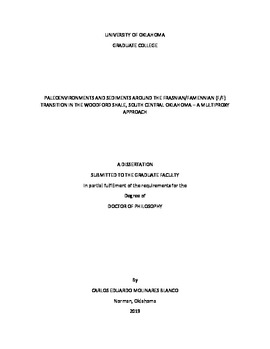| dc.contributor.advisor | Slatt, Roger | |
| dc.contributor.author | Molinares Blanco, Carlos Eduardo | |
| dc.date.accessioned | 2019-12-16T15:11:17Z | |
| dc.date.available | 2019-12-16T15:11:17Z | |
| dc.date.issued | 2019-12-13 | |
| dc.identifier.uri | https://hdl.handle.net/11244/323232 | |
| dc.description.abstract | The Woodford Shale (WDS) and the overlying Mississippian aged units are one of the most prolific unconventional reservoirs in the United States. This PhD dissertation includes three related studies that investigate the possible local and global controls on the distribution of the organic-rich Woodford Shale deposits, situated in the southcentral part of Oklahoma. The first publication describes the importance of the paleo-topography as a critical factor in the exploitation of unconventional reservoirs. Pre-Woodford Shale sub-crop maps provide a helpful guide for recognizing "sweet-spots" corridors associated with the accumulation of the Late Devonian - Early Mississippian rocks. In the Arkoma basin, synclinal structures cored by Hunton Group limestones could have been more resistant to erosion, whereas anticlinal structures, deeply eroded or cored by softer intervals (such as the Sylvan Shale), were more easily eroded and created narrow corridors where thicker and highly prospective Early-Mississippian coarse-grained sediments were accumulated. The second chapter introduced the vertical anisotropy (bedding/layering), as another important element in the characterization of unconventional reservoirs. Thomsen’s coefficients epsilon (ε) and gamma (γ), values obtained from Ultra Pulse Velocities (UPV) analysis were used to quantify anisotropy and to explore their effect on rock brittleness. In fact, more laminae at brittle intervals possibly created planes of weakness that assist in reducing the effective minimum horizontal stress and break rock easier. Thomsen’s ε and 𝛾 coefficients are proposed as proxies to estimate the effect of anisotropy on rock brittleness. Thomsen’s coefficients have an advantage compared to other methods to determine vertical anisotropy because these coefficients may be applicable under a wide variety of observation scales, such as those recorded by 3D seismic surveys, borehole seismic, micro seismicity, sonic well logs and UPV core analysis. The last chapter is a multiproxy research using a combination of stable carbon isotopes, spectral natural gamma-ray logs, scanning electron microscope images - coupled with an energy dispersive X-Ray analyzer (SEM-EDX), powder X-ray diffraction (XRD), X-ray fluorescence (XRF), and palynological analysis in samples from the Wyche-1 research well. The results confirm the age of the Woodford Shale (Late Devonian – Early Mississippian) and correlate a stable carbon isotopic curve obtained from Woodford Shale samples, with a series of positive Carbon excursion events associated with the Frasnian/Famennian (F/F) transition and the global extended Kellwasser anoxic events. The preservation of the organic matter in the Woodford Shale was the result of deep-water stagnation, low dilution rates, high salinity/dense vertical oceanic stratification, deep-water oxygen depletion, with no clear evidences of a shallow marginal sill southward. The preservation of organic matter in the Woodford Shale was largely influenced by relative sea level changes by controlling key primary productivity elements including: marine salinity, the influx of key nutrient (e.g. Fe-influx), water oxygenation, deep-water marine circulation and sedimentation/dilution rates. | en_US |
| dc.language | en | en_US |
| dc.subject | Frasnian-Famennian extinction | en_US |
| dc.subject | Woodford Shale | en_US |
| dc.subject | Unconventional Reservoir | en_US |
| dc.subject | Shales anisotropy | en_US |
| dc.subject | Late-Devonian paleogeography | en_US |
| dc.subject | Plants evolution | en_US |
| dc.subject | Kellwasser anoxic events | en_US |
| dc.subject.lcsh | Petroleum--Geology--Woodford Shale (Okla. and Texas) | |
| dc.subject.lcsh | Geology, Structural--Woodford Shale (Okla. and Texas) | |
| dc.subject.lcsh | Geology, Stratigraphic--Devonian | |
| dc.subject.lcsh | Anisotropy | |
| dc.title | Paleoenvironments and sediments around the Frasnian/Famennian (F/F) transition in the Woodford Shale, south central Oklahoma – a multiproxy approach | en_US |
| dc.contributor.committeeMember | Devegowda, Deepak | |
| dc.contributor.committeeMember | Elmore, Douglas | |
| dc.contributor.committeeMember | Marfurt, Kurt | |
| dc.contributor.committeeMember | Etayo, Miguel | |
| dc.date.manuscript | 2019-12-13 | |
| dc.thesis.degree | Ph.D. | en_US |
| ou.group | Mewbourne College of Earth and Energy::School of Geosciences | en_US |
| shareok.orcid | https://orcid.org/0000-0001-6688-8952 | en_US |
